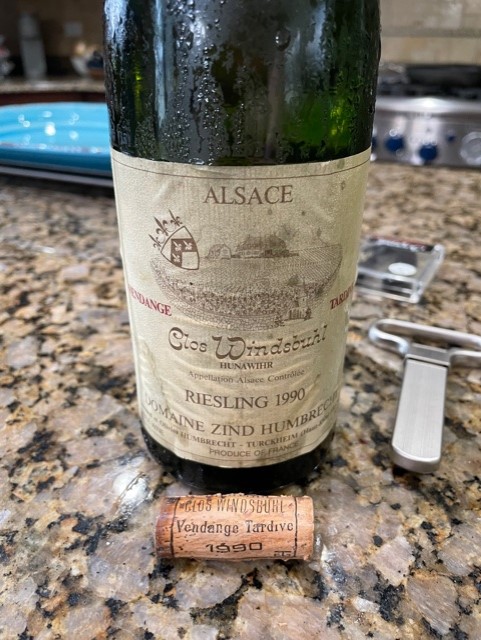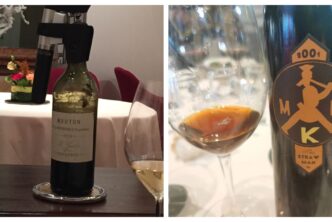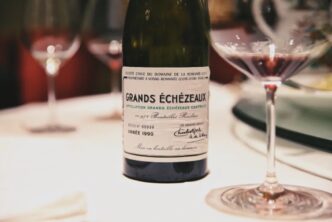Château Haut-Brion 1981 Château Haut-Brion Pessac-Léognan 94

Château Haut-Brion is one of the grandest names in wine and one of the properties I most enjoy visiting anywhere in the world. Now going on twenty years plus of annual visits with few interruptions along the way (Covid for one, and so I haven’t been there yet this year), I just never cease to be amazed how good Haut-Brion’s wines are even in difficult vintages. And like no other Bordeaux property, it is spectacularly adept at making not just world class, one of a kind red wines, but unforgettably good white wines too. The name “Haut-Brion” derives from the ancient French word “motte” or mound, but going farther back still to the old Celtic term “briga” (which like motte, also means a rise or mound in the land). Vines have been grown here since almost forever, and not unlike similar stories all over Europe, the original wine production was closely linked to the Church and the need for wine in order to officiate the Mass. Records detail that the wine was produced for a local chapel founded by Menuts Monks (Cordeliers monks who most probably lived in a place called ‘Les Menuts‘ outside the town walls). Documents show that the wine was produced thanks to the grapevines tended by a Johanna Faure at Haut Mont (more or less today’s Haut-Brion) as early as September 6, 1426. In fact, the exact birthdate of wine production from vines grown at Haut-Brion proper is pegged at 1521, when the estate was known as Aubrion; and so maybe Haut-Brion hasn’t really been around forever, but over six hundreds years of history is still pretty impressive (and it makes it the oldest continuously functioning Château in all Bordeaux). For all its gloried past (and for once, I won’t even write about the well-known Samuel Pepys anecdote), the modern age of Haut-Brion is just as impressive as its ancient one. It begins with the estate’s acquisition by American Clarence Dillon in 1935. In 1967, the grand-daughter of Clarence Dillon, Joan Dillon, married Prince Charles of Luxembourg, and as of 2008, it is Prince Robert of Luxembourg who took over management of Château Haut-Brion. But there can be no doubt that that the other family name to which Haut-Brion owes much of its fame is that of Delmas. Today, Château Haut-Brion (as well as Château La Mission Haut-Brion, its sister property in Pessac-Léognan, and Quintus in Saint-Emilion) are managed by Jean-Philippe Delmas. Jean Philippe Delmas is third Delmas generation to manage Haut-Brion, preceded by his father Jean-Bernard Delmas and his grandfather Georges. Therefore, the Delmas family has been very closely associated with Haut-Brion for close to a century (Georges Delmas became the director of Haut Brion in 1924). Given the undeniable talents of all the Delmas family members, it is safe to say the estate has really been none the worse for wear (and, I would like to add, very capably helped by super-talented technical director Jean-Philippe Masclef). The achievements the Delmas family boasts are noteworthy: clearly, the fact that Haut-Brion is now considered, by most if not all the wine experts, as one of the world’s ten or twelve greatest red wines would be quite a feather in anyone’s cap. But Jean-Bernard Delmas was also responsible for the uniquely shaped bottle that so characterizes the wine and for ensuring that Haut-Brion was one of the first estates in Bordeaux to vinify the wine in temperature-controlled stainless steel vats. Jean Philippe Delmas, in charge since 2003, has greatly increased the wine quality by lowering yields and reducing production of the grand vin (while roughly 21,000 cases were made in 1982, only there were only about 8,100 in 2010). Firthermore, he ahs greatly intensified and pushed a clonal and massals election program of the estate’s old vines, ensuring that the heart and soul of what makes Haut-Brion so special (its grapes: few people know for example that Haut-Brion owns not so arguably the very best Cabernet Franc of all the left bank). From a slightly difficult year that nobody will ever mistake for a century vintage, the Château Haut-Brion 1981 Château Haut-Brion Pessac-Léognan is just drinking beautifully and is far better than what some inordinately and unrealistic (dare I say misguided and unfair? I do) low scores that have been attributed to this wine over the years might lead you to believe. Medium-dark red with a garnet rim (as a 40 years old wine should always have), the 1981 Château Haut-Brion offers delicate, perfumed aromas of red and dark berries, woodsy underbrush, tobacco, cumin and cardamom. Fresh and juicy with suave tannins and harmonious acidity, the flavours similar to the aromas are nicely extended on the gentle, long finish that features repeating notes of faded forest floor and mint. There’s an absolutely captivating sense of balance and delicacy here at every sip that you won’t soon forget. A Cabernet Sauvignon, Cabernet Franc and Merlot blend, this can still last a little longer in a good cellar, but why take the risk? My suggestion is to enjoy it now, for this delicate beauty is really something to marvel at and enjoy presently. Drinking window: now- 2026
Zind Humbrecht 1990 Riesling Clos Windsbuhl Vendanges Tardives 98

OK, I’ll be frank as well as Ian: the Clos Windsbuhl is one of my ten favourite vineyards in the world. Simply put, its limestone-rich soil delivers late harvested Riesling and especially Pinot Gris wines of unbelievable focus, precision and depth, and I simply never tire of its wines. Characterized by a generally higher altitude than other vineyards in the Zind-Humbrecht portfolio (the Clos sits at roughly 350 meters above sea level), its cold calcareous-rocky soil (or more precisely, Muschelkalk limestone sub-layer rich in seashell fossils with various clay types and chalky rock, with very thin topsoil throughout most of the site) and location near a forest all combine to make this the latest ripening site in the Zind Humbrecht portfolio of star-studded vineyard sites (that the Clos Windsbuhl is not classified as a grand cru is a problem of Alsatian wine law I won’t get into, here- but I will, soon enough). What all that means is that grapes benefit from extremely long hang time and build up levels of complexity and depth that are then invariably very evident in the wines (a great example is provided by the wines of the difficult 2006 vintage: at Zind Humbrecht, the Clos Windsbuhl wines might be the best of that year). Facing south to south-east, the Clos is also quite steep (with a gradient hovering between between 15 and 40%). Although almost always harvested relatively late in the year, the Clos Windsbuhl rarely gets hit by much Botryitis cinerea (that’s me you hear whimpering), but grapes have no trouble ripening fully. The wine is made in the most traditional of ways meant to highlight expression of terroir (as it is with all of Zind Humbrecht’s many great wines) and so extended pressing cycles, abbreviated clarification cycles (to ensure safeguarding of natural yeasts and malloproteins in the must), and extended lees contact and aging are de rigueur here. Depending on the vintage, the Clos Windsbuhl is aged usually for eighteen-twenty-four months in large old French barrels. The Zind Humbrecht 1990 Riesling Clos Windsbuhl Vendanges Tardive is a thing of beauty. Luminous golden yellow in colour, it explodes from the glass with aromas of ripe yellow peach, cinnamon-baled apples, tangerine jelly, honey, and amazing minerality. Preserved lemon peel nuances emerge on the palate, along with an array of ripe fruit and honey that is reminiscent of the aromas nicely lifted by zingy, citrussy acidity typical of its limestone terroir. At once suave and thick, this luscious but brightly acid Riesling lasts and lasts on an impressively long, nuanced finish. It is a magnificent wine and a very fine follow-up to the absolutely perfect 1989 Pinot Gris Clos Windsbuhl Vendanges Tardives, which, while I’m at it, let me just say is one of the greatest sweet wines you will ever taste. The 1990 Riesling VT is only marginally behind that beauty, but how I wish now I hadn’t drink up all my bottles of this unforgettable nectar already many many years ago. Buy whatever you can find, you’ll thank me later. Drinking window: now- 2040.

 English
English

